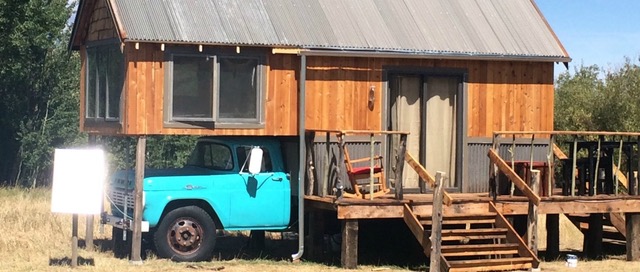The Stats (estimates that applied as of March 2018 based on a staff report by Housing Director April Norton):
- 25,723 people work in Teton County.
- There are 13,146 dwelling units in Teton County.
- 868 are deed restricted and house 6% (~1,543 people) of the workforce.
- 600 are employer-specific (built by employer) or LDR restricted (such as an accessory unit) and house 4% of the workforce (~1,029 people).
- 2,559 are market rental units (~4,116 people).
- 4,289 are market ownership (~7,974 people).
- 1,280 units are occupied by non-workers. If occupants are local—for example retired—each of these units might generate the need for 0.221 employees for a 4,000 sq foot home or roughly 283 employees (here’s the highly technical study upon which these numbers are based).
- 3,868 units are vacant. If occupants are non-local—for example, second homeowners—each of these homes generates the need for 0.266 employees for detached units and 0.398 employees for all other units (such as a 4 Season’s townhomes) amounting to around 1,160 employees.
- 5,148 units (39%) generate the need for workers without providing any workers.
- At 1.73 employees per unit, 7,998 units remaining would house 13,837 workers, or roughly 54% of the workforce. Current estimates are that 59% of workers live locally.
The supply: (The public investment, a substantial portion of which is through land, in the following projects amounts to over $14 million dollars)
- Redmond Street Rentals just added 26 deed-restricted rental units
- Grove Phase 3 just added 8 deed-restricted rental and will add 16 more over the next two years
- Housing associated with Parks and Rec Maintenance building will add 26 rental units by late 2019.
- Construction to start in 2019 should add 30 rental units at 174 N King Street in Jackson
- Construction on 90 non-deed restricted units should begin soon on West Broadway (Sagebrush Apartments)
- Hidden Hollow will soon add 169 units, 73 of which will be deed-restricted, mostly rentals, for the local workforce.
- There are other opportunities in town that April Norton is working on that would bring economies of scale to play and possibly result in over 100 more new units.
The Reality:
- Current policy is to house 65% of Teton County’s workforce in Teton County, a goal set by examining other Rocky Mountain resort communities and estimating the ratio that seems to separate places that are communities first and resorts second from places that are mostly resorts (background). Following that policy, for every 100 new full-time jobs created, at least 35 people have to live outside of Teton County whether they choose to or not. It will be very expensive to meet that goal.
- Just how expensive? Modest, two to three br houses from the late 80’s in Cottonwood Park are priced at over $800,000. Prices are higher yet in Rafter J and higher yet in Melody Ranch and portions of East Jackson. When it comes to vacant land, the 21-acre Bar J Chuckwagon property off of 390 was to be sold to a developer for $16 million. Another 80-acre parcel well south of town, no Teton views, rural and not zoned for density, was listed at $12 million (the hope by the owner is that it would be up-zoned for new housing). Building costs are expensive—estimated to be $450/sq foot minimum (a 1,000 foot building would cost $450,000 just to build). The Bar J developer wanted to build 69 units, 20 of which would have been deed-restricted affordable. $16 million divided by 69 makes the land cost $231,884/unit. For a 1,000 square foot unit, that means $450,000+$231,885=$681,884 at a minimum (doesn’t include infrastructure, profit margin, etc.) At seven or eight hundred thousand dollars a unit, the 49 market units would have been priced out of reach of most Teton County workers.
- Going forward, for a significant number of new homeowners and renters, multi-family units will be the most available and affordable option
The challenge: Given the price of land and the cost of construction, how do we capture as much new housing development for the working class and not for second homeowners or retirees? Should zoning allow development in areas of rural, open space? If so where? If so, how do we ensure it won’t impact wildlife either by taking up important habitat or creating more traffic through wildlife movement corridors? How much potential is there for infill in town? And most importantly, how do we ensure that new housing development doesn’t target the marketable and willing to pay $1 million or more for a place to live in Teton County? In short, how do we preserve the important components of our community—both the people (hard-working, free-spirited locals) and the place (open space, agriculture, wildlife habitat, wildlife).
The bottom line: New development, especially new second homes, new short-term rental units, and new commercial and institutional space, creates jobs, and job growth is outpacing housing growth. Since 2000, jobs have increased at an annual rate of 2.1% while housing growth has remained around 1.6% (helpful video). There are over 5,000 dwelling units out of 13,000 that don’t house any workers but generate the need for new employees (and thus new housing). From a pure free-market perspective, without any obligation on the part of the developer, most new housing built would target people able to pay prices in excess of $1 million—far more than the local workforce can afford. Meeting the challenge above means taking advantage of public dollars to purchase space, optimally in town, and utilize private entrepreneurialism and efficiencies to develop a range of deed-restricted rental and ownership housing and take up space that would otherwise go towards higher-end units, short-term rentals or commercial. In short, that means realigning housing growth to match job growth while using size and style of units combined with deed restrictions to ensure they remain in the hands of local workers.

